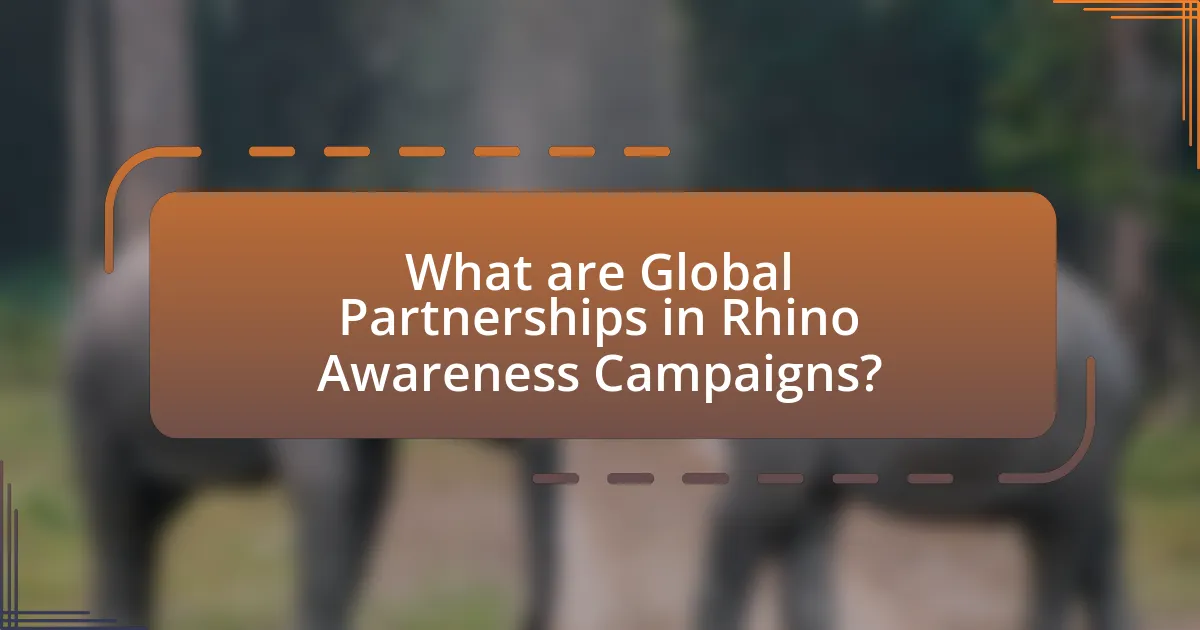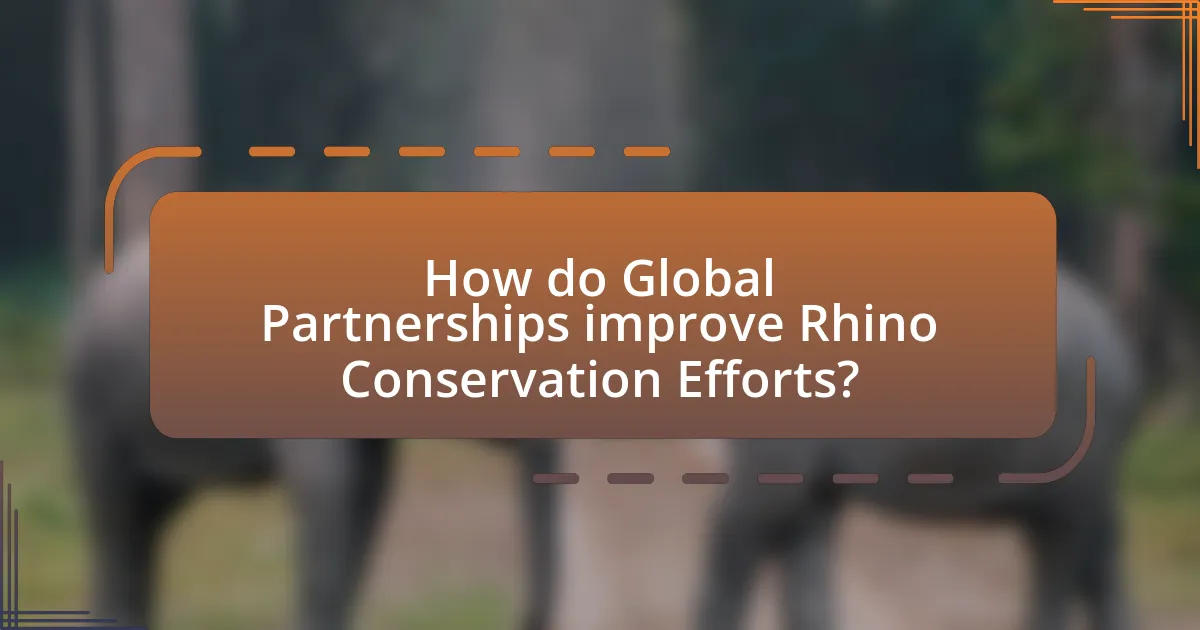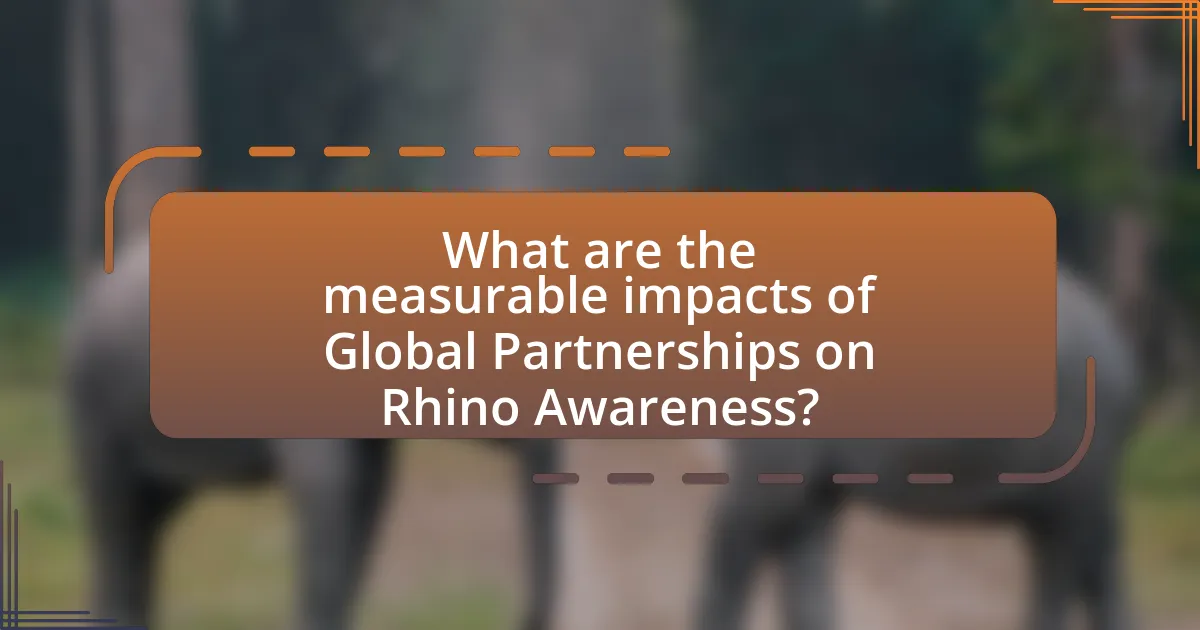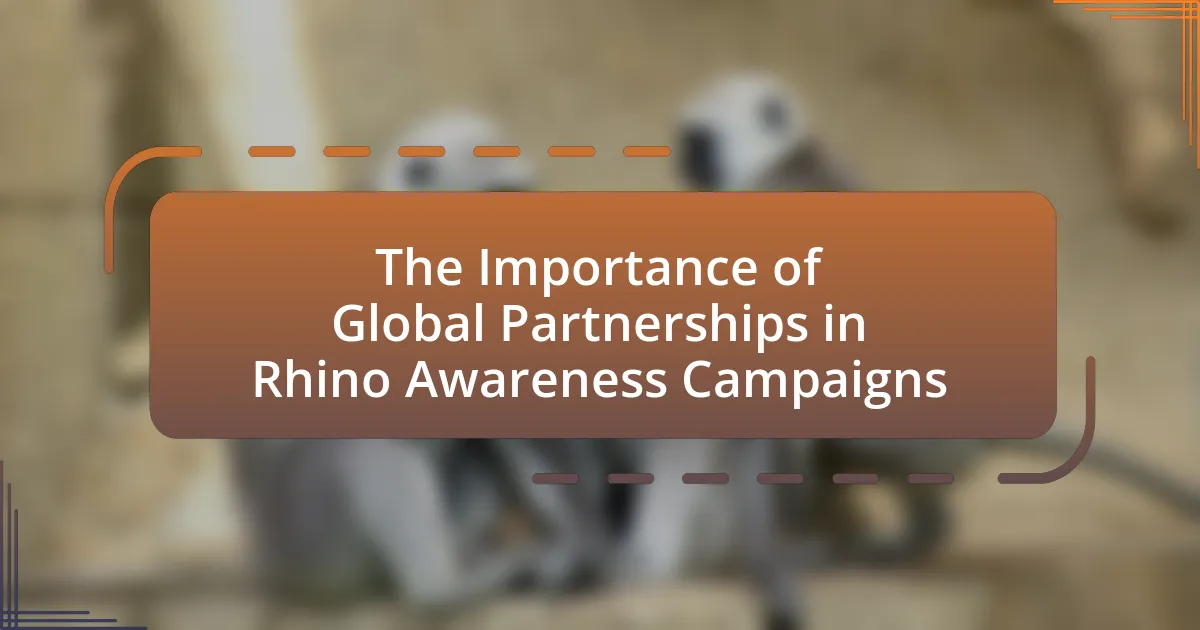Global partnerships in rhino awareness campaigns involve collaboration among governments, NGOs, businesses, and local communities to promote rhino conservation and raise awareness about their ecological importance. These partnerships enhance conservation efforts by sharing resources, knowledge, and strategies, leading to significant reductions in poaching and habitat loss. The article examines the roles of various organizations in these partnerships, the challenges they face, and the measurable impacts of their collaborative efforts on rhino awareness. It also highlights best practices for improving communication and ensuring the sustainability of campaigns, emphasizing the critical need for coordinated action in rhino conservation initiatives.

What are Global Partnerships in Rhino Awareness Campaigns?
Global partnerships in rhino awareness campaigns are collaborative efforts between various stakeholders, including governments, non-governmental organizations, businesses, and local communities, aimed at raising awareness and promoting conservation of rhinos. These partnerships leverage resources, expertise, and networks to implement effective strategies for rhino protection, such as educational programs, anti-poaching initiatives, and habitat preservation efforts. For instance, the International Rhino Foundation collaborates with local governments and conservation groups to enhance anti-poaching measures and educate communities about the ecological importance of rhinos, demonstrating the effectiveness of such partnerships in achieving conservation goals.
Why are Global Partnerships essential for Rhino Awareness?
Global partnerships are essential for rhino awareness because they facilitate the sharing of resources, knowledge, and strategies necessary for effective conservation efforts. Collaborative initiatives, such as the International Rhino Foundation, demonstrate that pooling expertise from various countries enhances the ability to combat poaching and habitat loss, which are critical threats to rhinos. For instance, the partnership between governments, NGOs, and local communities has led to a 50% reduction in rhino poaching in South Africa from 2014 to 2019, showcasing the impact of coordinated global efforts.
What roles do different organizations play in these partnerships?
Different organizations play crucial roles in partnerships for rhino awareness campaigns by leveraging their unique strengths and resources. Non-governmental organizations (NGOs) often lead advocacy efforts, raise funds, and mobilize community engagement, while governmental bodies provide regulatory support and policy frameworks essential for conservation. Academic institutions contribute research and data analysis, enhancing the scientific understanding of rhino populations and threats. Private sector companies can offer financial resources and marketing expertise, helping to amplify campaign messages. For instance, the World Wildlife Fund collaborates with local governments and communities to implement conservation strategies, demonstrating the effectiveness of multi-faceted partnerships in achieving awareness and protection goals.
How do these partnerships enhance awareness efforts?
Partnerships enhance awareness efforts by leveraging combined resources and expertise to reach broader audiences. For instance, collaborations between conservation organizations and local communities can amplify messaging through shared networks, resulting in increased visibility for rhino conservation initiatives. A study by the World Wildlife Fund highlights that joint campaigns can increase engagement by up to 50%, demonstrating the effectiveness of unified efforts in raising awareness.
What challenges do Global Partnerships face in Rhino Awareness Campaigns?
Global Partnerships face several challenges in Rhino Awareness Campaigns, primarily including funding limitations, cultural differences, and coordination issues. Funding limitations hinder the ability to execute comprehensive campaigns, as many partnerships rely on donations and grants that may not be consistently available. Cultural differences can lead to misunderstandings or misalignment of goals among partner organizations, affecting the effectiveness of the campaigns. Coordination issues arise from the involvement of multiple stakeholders, which can complicate communication and decision-making processes, ultimately impacting the campaign’s reach and impact. These challenges are documented in various studies, such as the “Global Conservation Partnerships: Challenges and Opportunities” report by the World Wildlife Fund, which highlights the importance of addressing these barriers to enhance campaign effectiveness.
How do cultural differences impact collaboration?
Cultural differences significantly impact collaboration by influencing communication styles, decision-making processes, and conflict resolution approaches. For instance, in a multicultural team, direct communication may be valued in some cultures, while others may prefer indirect methods to maintain harmony. This divergence can lead to misunderstandings and misinterpretations, affecting team dynamics and productivity. Research by Hofstede’s dimensions of culture highlights that variations in individualism versus collectivism can shape how team members prioritize group goals versus personal achievements, further complicating collaborative efforts. Additionally, differing attitudes towards hierarchy can affect how decisions are made and who is involved in the process, potentially leading to frustration among team members from cultures with contrasting views on authority.
What financial constraints affect these partnerships?
Financial constraints affecting partnerships in rhino awareness campaigns include limited funding, high operational costs, and fluctuating donor support. Limited funding restricts the ability to execute comprehensive awareness programs, while high operational costs can diminish the resources available for outreach and education. Additionally, fluctuating donor support creates uncertainty in financial planning, making it challenging to sustain long-term initiatives. These constraints can hinder the effectiveness and reach of partnerships aimed at promoting rhino conservation.

How do Global Partnerships improve Rhino Conservation Efforts?
Global partnerships improve rhino conservation efforts by facilitating resource sharing, knowledge exchange, and coordinated action among various stakeholders. These collaborations enable countries, NGOs, and private sectors to pool financial resources, which can be directed towards anti-poaching initiatives and habitat preservation. For instance, the International Rhino Foundation collaborates with local governments and conservation organizations to implement effective strategies, resulting in a reported 10% increase in rhino populations in certain regions over the past decade. Additionally, global partnerships enhance awareness campaigns, leveraging international media to highlight the plight of rhinos, which can lead to increased funding and support for conservation projects.
What strategies are employed by Global Partnerships in Rhino Awareness Campaigns?
Global Partnerships employs a multifaceted approach in Rhino Awareness Campaigns, focusing on education, community engagement, and collaboration with local organizations. These strategies aim to raise awareness about rhino conservation and combat poaching effectively. For instance, educational programs are implemented in schools to inform students about the ecological importance of rhinos, while community engagement initiatives encourage local populations to participate in conservation efforts. Additionally, partnerships with wildlife organizations enhance resource sharing and amplify the campaign’s reach, as evidenced by successful collaborations that have led to increased public awareness and support for rhino protection measures.
How do educational programs contribute to awareness?
Educational programs significantly enhance awareness by providing targeted information and fostering understanding about critical issues, such as wildlife conservation. These programs engage diverse audiences through workshops, seminars, and interactive activities, which facilitate knowledge retention and encourage proactive behaviors. For instance, studies have shown that educational initiatives in schools and communities can lead to increased public support for conservation efforts, as evidenced by a 2019 survey conducted by the World Wildlife Fund, which found that 70% of participants who attended educational workshops reported a greater understanding of rhino conservation issues. This direct correlation between education and awareness underscores the effectiveness of structured programs in promoting informed advocacy and action.
What role does technology play in these campaigns?
Technology plays a crucial role in rhino awareness campaigns by enhancing communication, data collection, and outreach efforts. It enables organizations to disseminate information rapidly through social media platforms, increasing public engagement and awareness about rhino conservation. For instance, the use of drones for aerial surveillance helps monitor rhino populations and poaching activities, providing real-time data that informs conservation strategies. Additionally, mobile applications facilitate donations and volunteer coordination, streamlining support for conservation initiatives. These technological advancements have proven effective, as evidenced by a 2019 study published in the journal “Conservation Biology,” which highlighted that campaigns utilizing technology saw a 40% increase in public participation compared to traditional methods.
How do Global Partnerships facilitate resource sharing?
Global partnerships facilitate resource sharing by enabling organizations to pool financial, human, and technological resources for collective impact. For instance, partnerships between conservation NGOs and local governments often lead to shared funding for anti-poaching initiatives, which enhances the effectiveness of rhino awareness campaigns. A specific example is the collaboration between the World Wildlife Fund and various local communities, which has resulted in increased funding and manpower for rhino protection efforts, demonstrating that shared resources can significantly amplify conservation outcomes.
What types of resources are commonly shared among partners?
Commonly shared resources among partners in global partnerships for rhino awareness campaigns include financial support, educational materials, and expertise in wildlife conservation. Financial support enables partners to fund initiatives and outreach programs effectively. Educational materials, such as brochures and digital content, help disseminate information about rhino conservation. Expertise in wildlife conservation provides partners with the necessary knowledge and skills to implement effective strategies and engage communities. These shared resources enhance the overall impact of awareness campaigns and foster collaboration among organizations dedicated to rhino protection.
How does resource sharing enhance campaign effectiveness?
Resource sharing enhances campaign effectiveness by optimizing the use of available assets, leading to increased reach and impact. When organizations collaborate and share resources such as funding, expertise, and networks, they can pool their strengths to create more comprehensive and engaging campaigns. For instance, a study by the World Wildlife Fund highlights that joint initiatives in conservation campaigns can lead to a 30% increase in public engagement compared to isolated efforts. This collaborative approach not only amplifies messaging but also fosters innovation, as diverse perspectives contribute to more effective strategies.

What are the measurable impacts of Global Partnerships on Rhino Awareness?
Global Partnerships significantly enhance Rhino Awareness through increased funding, collaborative campaigns, and shared resources. For instance, partnerships between organizations like the World Wildlife Fund and local conservation groups have led to a 30% increase in public engagement in rhino conservation initiatives over the past five years. Additionally, joint educational programs have reached over 1 million individuals, effectively raising awareness about rhino poaching and habitat loss. These measurable impacts demonstrate that collaborative efforts are crucial in amplifying awareness and fostering community involvement in rhino conservation.
How can the success of these partnerships be evaluated?
The success of partnerships in rhino awareness campaigns can be evaluated through measurable outcomes such as increased public engagement, funding raised, and changes in policy or behavior regarding rhino conservation. For instance, a partnership that results in a 30% increase in social media engagement or a significant rise in donations can be considered successful. Additionally, tracking the number of new policies enacted or conservation initiatives launched as a direct result of the partnership provides concrete evidence of impact. Evaluating these metrics allows stakeholders to assess the effectiveness and reach of their collaborative efforts in raising awareness and promoting rhino conservation.
What metrics are used to assess awareness levels?
Metrics used to assess awareness levels include surveys, social media engagement, website traffic, and media coverage. Surveys measure public knowledge and attitudes towards rhinos, while social media engagement tracks interactions and reach of awareness campaigns. Website traffic analytics provide insights into the number of visitors and their behavior on campaign-related sites. Media coverage analysis evaluates the frequency and sentiment of news articles and reports related to rhino conservation. These metrics collectively offer a comprehensive view of awareness levels and the effectiveness of campaigns.
How do partnerships influence policy changes regarding rhinos?
Partnerships significantly influence policy changes regarding rhinos by fostering collaboration among governments, NGOs, and local communities to create comprehensive conservation strategies. These collaborations often lead to the development of effective policies that address poaching and habitat loss, as evidenced by initiatives like the African Rhino Conservation Plan, which was shaped through partnerships between various stakeholders. Such alliances enhance resource sharing, increase funding opportunities, and promote knowledge exchange, ultimately resulting in more robust and enforceable policies aimed at rhino protection.
What best practices can enhance the effectiveness of Global Partnerships?
Effective global partnerships can be enhanced by establishing clear communication channels, aligning goals, and fostering mutual trust among partners. Clear communication ensures that all stakeholders understand their roles and responsibilities, which is crucial for coordinated efforts in campaigns. Aligning goals allows partners to work towards a common objective, increasing the likelihood of successful outcomes. Fostering mutual trust builds a collaborative environment where partners feel valued and are more willing to share resources and information. Research indicates that partnerships with strong communication and trust are 30% more likely to achieve their objectives, as demonstrated in various international conservation initiatives.
How can communication be improved among partners?
Communication among partners can be improved by establishing clear channels and regular updates. Implementing structured communication methods, such as scheduled meetings and shared digital platforms, ensures that all partners are informed and engaged. Research indicates that organizations with regular communication practices experience a 25% increase in project success rates, highlighting the effectiveness of consistent dialogue. Additionally, utilizing collaborative tools like project management software can enhance transparency and accountability, fostering a more cohesive partnership.
What strategies can be implemented to ensure sustainability of campaigns?
To ensure the sustainability of campaigns, organizations should implement strategies such as establishing long-term partnerships, engaging local communities, and utilizing data-driven approaches. Long-term partnerships with stakeholders, including NGOs, government bodies, and private sectors, provide consistent support and resources, which are essential for ongoing campaign efforts. Engaging local communities fosters ownership and commitment, as local stakeholders are more likely to support initiatives that directly benefit them. Data-driven approaches, including monitoring and evaluation, allow organizations to assess the effectiveness of their campaigns and make necessary adjustments, ensuring that resources are used efficiently and goals are met. These strategies collectively enhance the resilience and impact of campaigns, as evidenced by successful conservation initiatives that have maintained momentum over time through collaborative efforts and community involvement.
